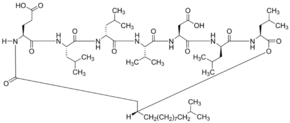All AbMole products are for research use only, cannot be used for human consumption.

Surfactin is a lipopeptide antibiotic that is composed of one β-hydroxy fatty acid, used as a surfactant to mediate flux of mono-and divalent cations, such as calcium, across lipid bilayer membranes, also used as adjuvant. It is a powerful biosurfactant that causes lysis of erythrocytes and bacteria. It is also a clotting inhibitor. Surfactin is thought to disrupt or disintegrate membranes via physicochemical interaction with the membranes.
| Molecular Weight | 1036.34 |
| Formula | C53H93N7O13 |
| CAS Number | 24730-31-2 |
| Solubility (25°C) | Water 20 mg/mL DMSO 30 mg/mL |
| Storage | 2-8°C, dry, sealed |
| Related Adjuvants Products |
|---|
| 25-OH Vitamin D3/BSA
25-OH Vitamin D3/BSA is an antigen-adjuvant coupling of 25-OH Vitamin D3 conjugated to bovine serum albumin (BSA). |
| Schizophyllan
Schizophyllan, a β-D-glucan derived from Schizophyllan, activates Tc cells, NK cells, macrophages, as well as promotes the secretion of various lymphokines such as IL-1, IL-2, IL-3, IFN. It can be used as an immune adjuvant with potential immunomodulatory and antitumor activities. |
| Aluminum Phosphate
Aluminum Phosphate is a widely used adjuvant and has been shown to increase the excretion rate of strontium for use in studies related to vaccines and gastrointestinal diseases. |
| Peptidoglycan
The peptidoglycan (murein) sacculus is a unique and essential structural element in the cell wall of most bacteria. This product is extracted from Bacillus subtilis. |
| QS-21
QS-21, an immunostimulatory saponin, could be used as a potent vaccine adjuvant. QS-21 stimulates Th2 humoral and Th1 cell-mediated immune responses through action on antigen presenting cells (APCs) and T cells. QS-21 can activate the NLRP3 inflammasome with subsequent release of caspase-1 dependent cytokines, IL-1β and IL-18. |
All AbMole products are for research use only, cannot be used for human consumption or veterinary use. We do not provide products or services to individuals. Please comply with the intended use and do not use AbMole products for any other purpose.


Products are for research use only. Not for human use. We do not sell to patients.
© Copyright 2010-2024 AbMole BioScience. All Rights Reserved.
